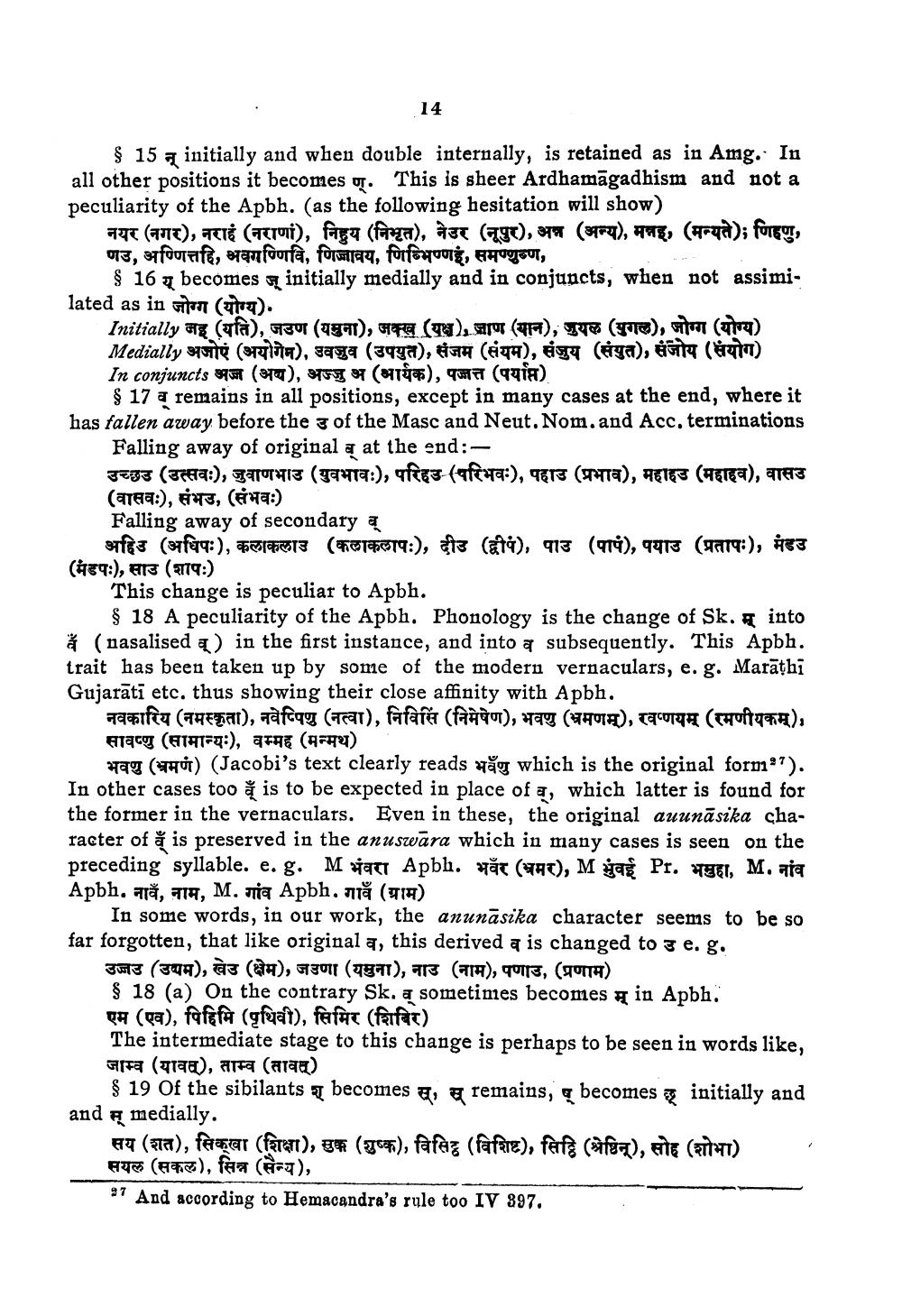________________
14
$ 15 , initially and when double internally, is retained as in Amg. In all other positions it becomes o. This is sheer Ardhamāgadhism and not a peculiarity of the Apbh. (as the following hesitation will show)
नयर (नगर), नराई (नराणां), निहुय (निभृत), नेउर (नूपुर), अन्न (अन्य), मन्नइ, (मन्यते); णिहणु, णउ, अण्णित्तहि, अवगणिवि, णिजावय, णिभिण्ण, समण्णुब्ण,
$ 16 L becomes ~ initially medially and in conjuncts, when not assimilated as in जोग्ग (योग्य).
Initially मह (यति), जउण (यमुना), जक्ख (यक्ष), जाण (यान), जुयल (युगल), जोग्ग (योग्य) Medially अजोएं (अयोगेम), उवजुव (उपयुत), संजम (संयम), संजुय (संयुत), संजोय (संयोग) In conjuncts अज (अब), अज्जु अ (भार्यक), पजत्त (पर्याप्त)
$ 17 a remains in all positions, except in many cases at the end, where it has fallen away before the 3 of the Masc and Neut. Nom.and Acc, terminations
Falling away of original a at the end:उच्छउ (उत्सवः), जुवाणभाउ (युवभावः), परिहउ (परिभवः), पहाउ (प्रभाव), महाहउ (महाहव), वासउ (वासवः), संभउ, (संभवः) Falling away of secondary a
अहिउ (अधिपः), कलाकलाउ (कलाकलापः), दीउ (द्वीप), पाउ (पाप), पयाउ (प्रतापः), मंडउ (मंडपः),साउ (शाप:)
This change is peculiar to Apbh.
$ 18 A peculiarity of the Apbh. Phonology is the change of Sk. / into 4 (nasalised) in the first instance, and into a subsequently. This Apbh. trait has been taken up by some of the modern vernaculars, e. g. Marathi Gujarati etc, thus showing their close affinity with Apbh.
नवकारिय (नमस्कृता), नवेप्पिणु (नत्वा), निविसि (निमेषेण), भवणु (भ्रमणम्), रवप्णयम् (रमणीयकम्), सावष्णु (सामान्यः), वम्मह (मन्मथ)
भवणु (भ्रमण) (Jacobi's text clearly reads भवॅणु which is the original forms?). In other cases too is to be expected in place of a, which latter is found for the former in the vernaculars. Even in these, the original auunāsika character of is preserved in the anuswara which in many cases is seen on the preceding syllable. e.g. M भंवरा Apbh. भवर (भ्रमर), M भुंवई Pr. भमुहा, M. नांव Apbh. नाव, नाम, M. गांव Apbh. गाव (ग्राम)
In some words, in our work, the anunāsika character seems to be so far forgotten, that like original a, this derived a is changed to 3 e. g.
उजउ (उधम), खेउ (क्षेम), जउणा (यमुना), नाउ (नाम), पणाउ, (प्रणाम) § 18 (a) On the contrary Sk. a sometimes becomes in Apbh. एम (एव), पिहिमि (पृथिवी), सिमिर (शिबिर) The intermediate stage to this change is perhaps to be seen in words like, जाम्व (यावत), ताम्व (तावत्)
$ 19 Of the sibilants श् becomes स्, स् remains, r becomes छ् initially and and a medially.
सय (शत), सिक्खा (शिक्षा), सुक (शुष्क), विसिह (विशिष्ट), सिहि (प्रेष्ठिन्), सोह (शोभा) सयल (सकल), सिन्न (सैन्य), 27 And according to Hemacandra's rule too IV 897.




